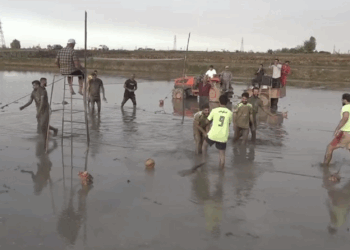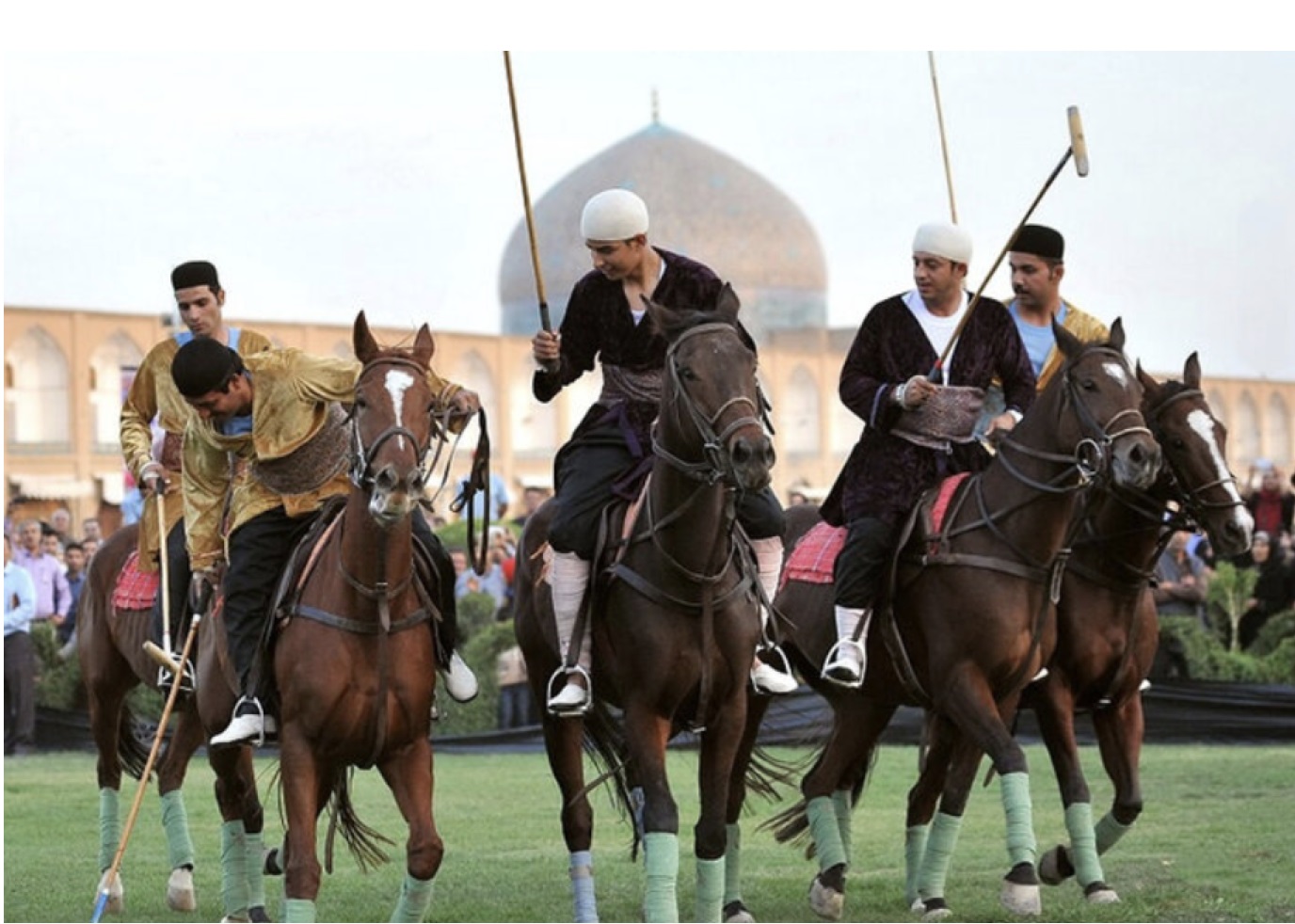March 15, 2024
As the month of Bahman yields to Esfand, the last month of the year, a centuries-old and pleasant aroma fills the air. No one can miss the new turn that life takes. Amou Now Ruz (Uncle New Year) is on his way and Now Ruz is fast approaching. As Esfand draws to a close, the pace of preparations for the annual celebrations becomes faster with everyone rushing to meet the deadline. Even the most indifferent get constant reminders from the black-faced Haji Firuzes popping up on the streets, singing and dancing to remind passersby that he only appears once a year “Haji Firuzam, Sali-ye rouzam” (I am Haji Firuz for one day a year.) Haji Firuz is the traditional herald of the Persian New Year.
He arrives in the last month (Esfand) to announce the coming of the New Year. Haji Firuz is accompanied by musicians and entertains people with music, songs, skits and poems. Prior to Now Ruz, the main preoccupation of housewives is spring cleaning or, as it is called in Persian, “khane tekani.” The whole house smells of freshness and the sparkling clean windows perfectly reflect the lights of the meticulously polished brass and crystal.
This is the time for housewives to put their creativity and imagination to work rearranging the furniture and redecorating their homes. Once done with spring cleaning, it is time for baking cookies and making sweets, completing the shopping list for the family members, with the articles for the Haft Seen (Seven S’s) table and new clothes for the kids topping the list of musts. Meanwhile, the elders double check their supply of new banknotes to make sure there is enough to go around so that each and every family member and visitor will get new notes, or eidi as it is called in Persian.
Some bless the money by storing the bills in among the pages of the Qoran while others write “Sal-e Now Mobarak” (Happy New Year) on the bills and put their own signatures on them. The recipients, delighted by the generosity, keep the autographed money tucked away, since they are meant as a keepsake and are considered a sign of good fortune at the start of the year, promising much more to come throughout the rest of the year.
Stores and bazaars are packed with shoppers engaged in a race against time. For Iranians, Now Ruz is marked with the smell of spring flowers, cleanliness, new clothes and freshly printed banknotes. Kids are the most excited of all. They cannot wait for “saat-e tahvil” or the precise second of the arrival of the new year, the spring equinox. Immediately after the clock ticks over the year, they go to visit the elderly and receive their eidi.
Traditionally, the younger members bow to kiss the hands of their elders in a gesture of respect. The elders in turn offer the eidi, which varies according to the wealth of the giver and the closeness of the recipient. Normally, the smaller denominations of banknotes are kept for younger children who are impressed by the mere number of banknotes rather than their value a task made easier in modern Iran where the smallest banknote is 100 rials, worth less than 2/10,000ths of an American cent. After visiting the house of grandpa and grandma or the grand aunts and uncles, kids are impatient to add up their collections and boast to one another about how much money they have collected. Another service in great demand is provided by the hair salons and barbershops. Visiting the hairdresser is another must for people of all ages and both genders.
As a result, the final days of the year are the days to which any hairdresser looks forward throughout the year. Now Ruz is the only occasion in the course of the year where everyone gets to meet not only his or her close relatives and friends, but also the distant relatives and acquaintances, who, out of tradition and custom, must pay a courtesy visit to the oldest member of each family. This provides a good incentive for everyone to try to look his or her best. As a result, the garment shops and dressmakers all do a brisk business. Right after the turn of the year, one hears the deafening sounds of firecrackers.
Members of each household exchange greetings, hug and kiss one another, and then move to giving and receiving eidi. Immediately afterward, they begin the rounds of the relatives, starting with the eldest. Only after the eldest relatives have been seen will the family move on to other visits, prioritized in terms of closeness and age. Other shops doing great business at Now Ruz are the confectionary and nut stores. Shirini (sweets), topped with baklava, and ajeel (an assorted mixture of nuts, dried fruits and seeds) are the items in highest demand.
Even those housewives who pride themselves on being first-class cooks will have to drop by the sweet and nut shop to pick up their supply of tantalizing ajeel. There are two kinds of ajeel. Ajeel shirin or sweet dried fruits and unsalted dried nuts and seeds, are served on Chahar Shambeh Souri (the Tuesday night before the last Wednesday of the old year) and ajeel shur (salted ajeel), a delicious mixture of salted nuts and pistachios, are served to entertain Now Ruz visitors. To guarantee the supply, buyers have learned to place their New Year order well in advance of Now Ruz.
Experience has shown that walking into a sweet shop in the last few days of Esfand would mean finding very little or nothing at all. Nowadays, with people becoming more diet conscious, cutting down on sugar and counting carbs, shirinis served at Now Ruz have shrunk in size. Nonetheless, the aggregate of sweets consumed remains large, leading to that most common complaint after the holiday weight gain. Another business doing a better than usual trade is that of the fish sellers. The traditional Now Ruz dish is sabzi polo ba mahi (rice steamed with finely-chopped spring onions, coriander and parsley served with fried fish) along with kuku sabzi (a pie-like mixture of finely-chopped spring onion, spinach, parsley and coriander mixed with beaten eggs and fried fish).
But before one reaches New Ruz, one must first jump over a bonfire on Chahar Shambeh Souri, the evening before the last Wednesday of the old year. What we now know as Now Ruz dates back to the Sassanid era (224-642 CE), a dynasty that ruled until the advent of Islam 1,400 years ago. The celebrations were kicked off five days prior to the New Year. It was believed that foruhars (guardian angels) would come down to earth in those five days to visit their human counterparts.
To welcome the foruhars in the best possible fashion, spring cleaning was required, special fests and ceremonies were held and unique foods were prepared. Furthermore, bonfires were set on rooftops on Chahar Shambeh Souri to indicate to the guardian angels that humans were ready to receive them. Nowadays, Chahar Shambeh Souri is no longer a purification ritual but an evening of laughter and fun. The ancient Persians believed that jumping over the fire would enable them to get rid of their illnesses and shed their misfortunes and become invigorated and energized with the heat and warmth of the fire. The popular rhyme sung while jumping over the fire is “Zardi-e man az tow, Sorkhi-e tow az man.” I give you my pale color (implying an illness); I take your red color (sign of good health).
Another age-old tradition at Chahar Shambeh Souri is qashoq zani (beating a spoon against a metal bowl). After sunset, and taking advantage of the darkness, girls and boys cover themselves to hide their identities, take a metal bowl and spoon and knock on the doors of neighbors while hitting the spoon against the bowl. Those inside the house, alerted by the familiar sound, open the door and fill the bowl with ajeel.























